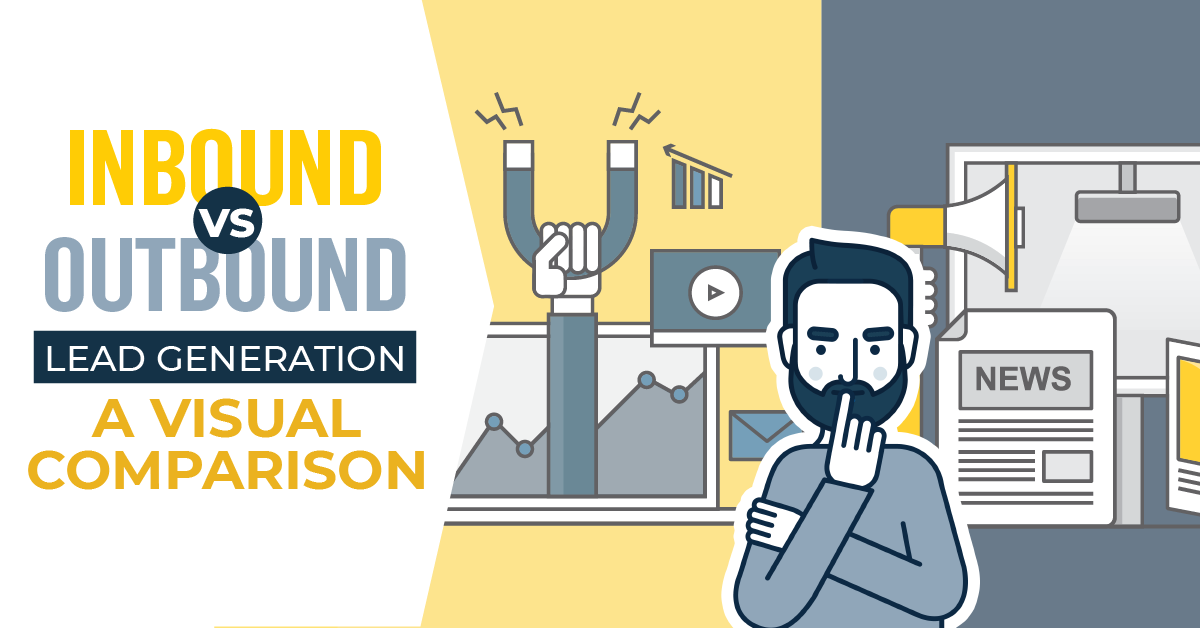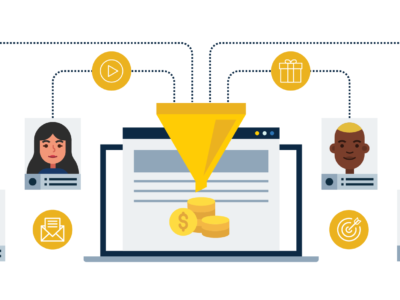Generating leads is a necessary part of any business’s sales process. With the digital age in full swing, capturing the attention of your target audience comes down to selecting the right approach. Two major approaches to lead generation exist—inbound and outbound.
But what sets inbound and outbound lead generation apart? The key differences between inbound vs. outbound lead generation lie in their techniques and purpose.
Inbound lead generation focuses on attracting customers to your website through helpful and relevant content like blogs, gated content, and online events. Meanwhile, outbound lead generation deals with spreading the word about your brand like ads, cold calling, and email marketing.
In this infographic, you will learn the similarities and differences of inbound and outbound marketing, as well as how these two can bring valuable insights to your lead generation efforts. If you want to know more, read our lead generation guide.

Outbound Lead Generation
Outbound lead generation involves reaching out to a target audience and pushing messages, regardless of their interest in your content or company. This is sometimes called “interruptive marketing.”
The Approach of Outbound Lead Generation
Outbound marketing is known as “interruptive marketing” for the simple reason that its methods interrupt the target audience’s habits. This is like how an ad disrupts the lineup of programs in a TV channel or how a cold call interrupts an employee’s workday.
The main approach of outbound prospecting relies on the brand starting the conversation with its audience. With the right strategies, this approach allows them to reach and interact with decision-making prospects actively.
Methods Used in Outbound Lead Generation
Outbound marketing includes many traditional marketing practices, in-person activities, and digital-based techniques. Here are some methods marketers use to generate leads using outbound marketing.
- Traditional Marketing Practices
- Cold calling
- Print and TV advertising
- Mailing lists
- Word of mouth
- In-person Activities
- Event sponsorships
- Trade shows
- Door-to-door pitches
- Digital-based Techniques
- Pop-up ads and banners
The strategies used for outbound marketing are more linear, as the same message is sent out through all available channels. Messages can be tweaked to fit a specific group or channel better but will be general enough to catch the interest of as many people as possible.
Skills Needed for Outbound Lead Generation
Outbound marketing relies on ads and copy to attract and compel prospects into taking action. Copywriting, graphic design, web design, and campaign management are critical skills for marketers taking this approach.
Strong interpersonal skills are also essential for cold calls and door-to-door pitches. As these people will be the first encounter prospects have with the brand, communicating well can easily turn prospects into customers.
The Cost of Outbound Lead Generation
The approach and methods of attracting inbound and outbound leads differ. So naturally, the costs will also vary. The cost profile of generating outbound leads is often high and more intensive due to the medium used to deliver the marketing campaigns. These tools include ads, mailing lists, and cold email lists.
Moreover, campaigns for outbound lead generation have shorter durations to manage failure risks. It may not be the best option to run the outbound marketing campaign for a long time if it’s unsuccessful.
Inbound Lead Generation
Inbound lead generation is focused on drawing in a target audience by providing them with valuable information and incentives. Rather than putting your brand message in front of them, inbound marketing helps you be visible to audiences already looking for what you have to offer. In this respect, inbound marketing can be seen as the opposite of outbound marketing.
The Approach of Inbound Lead Generation
Inbound marketing lies in giving the audience control over when they want to receive your message and how they receive it. Content plays a crucial role in attracting, educating, and enticing the audience to register, subscribe, or fill out a form.
Good content is critical in convincing prospects to open up a line of communication with the brand. Content that focuses on helping rather than selling builds trust with the audience and provides the right foundation for establishing a relationship.
Methods Used in Inbound Lead Generation
This approach heavily relies on digital tools like search engines and online platforms to lead prospects to valuable content they are interested in. Some of the techniques under inbound marketing are the following:
- Search engine optimization (SEO)
- Social media marketing
- Content marketing
Marketers also use other digital means to generate inbound leads, including:
- Online events like webinars
- Podcasts
- eBooks
- Whitepapers
- Audiobooks
If you use one of these techniques, ensure the voice quality beforehand to avoid technical issues or other failures during the sessions.
Skills Needed for Inbound Lead Generation
Creating content that delights and attracts visitors is a critical part of inbound marketing. Like with outbound marketing, planning, copywriting, and graphic design are essential skills for producing content that leaves an impact on prospects.
However, inbound marketing is largely a digital practice. Aside from the above skills, being knowledgeable in SEO and web design is a must for making these strategies work. Specialized knowledge in social media marketing, website management, community management, and certain digital tools will also be necessary in attracting and nurturing prospects.
The Cost of Inbound Lead Generation
Outbound lead generation can incur higher costs when running campaigns due to the channels your ads and messages need to be distributed in. This cost also comes with a higher risk of getting little to no conversions.
Meanwhile, inbound lead generation generally costs less as traffic is generated organically with the right content. Additionally, cost per lead lessens over time as content can yield leads for a longer, if not indefinite, period of time.
Pros of Outbound Marketing
Reaches a wider group of people
As inbound marketing focuses its efforts on prospects already searching for solutions or information, outbound marketing actively reaches out to its audience as a whole. This includes groups who may not even know your brand or its offerings.
At best, outbound marketing efforts can make prospects aware of their own unfulfilled needs that your brand can help solve.
More control over target leads and strategies
Outbound marketing relies on targeting specific demographics and using carefully planned campaigns. This gives your brand more control over the pool of prospects who can learn about you and can be further pushed into the funnel.
Additionally, creating and monitoring campaigns means relying on particular strategies and improving them when leads are expected to come in.
Get to leads ahead of competitors
Outbound marketing efforts are more active and aggressive, reaching your target audiences at any stage of the decision-making process. This means that when done correctly, you may get to prospects before your competitors do.
By establishing a relationship with the prospects before everyone else, you’re increasing the chances of them going further down the funnel and converting to sales.
Cons of Outbound Marketing
Interruptive by nature
The moment your ad plays, or when you make a cold call, you are taking a portion of your prospect’s time to convey your message. It’s no surprise that consumers and businesses alike are more resistant to marketing that forces them to engage with you.
From a digital perspective, ad blockers and spam filters have become prevalent among internet users. This makes it even more challenging to get your message across.
Limited to one-way communication
Using outbound marketing techniques means prospects usually receive one version of your message. This can be disadvantageous as your message may not address a prospect’s needs fully, causing them to pass on your offer.
With your brand regularly communicating and putting out marketing efforts, there may be little to no opportunity for feedback. This can lead to missing chances to better tailor your messages to the prospect’s needs.
Leads may not be ready to decide
The disruptive nature of outbound marketing is a double-edged sword. While you may be able to get to your target audience ahead of the competition, you may also reach them at a point where they aren’t ready to commit.
Convincing these prospects to consider your product may pose a challenge, especially for ones that have only learned about your brand.
Pros of Inbound Marketing
Lasts longer than other approaches
Inbound marketing assets can be “evergreen”—relevant and accurate, regardless of when it was made or shared. These assets can be reused, repurposed, or re-angled to suit a particular campaign better. With content rooted in digital spaces, it is less likely to go stale with continuous updating and maintenance.
This is unlike in outbound lead generation, where campaigns are shorter and more finite due to the level of risk and costs involved.
Establishes a brand’s expertise
Inbound leads and outbound leads may also differ in how they perceive and respond to your marketing campaigns. Since outbound lead generation techniques tend to be more aggressive, they can cause prospects to close up and reject your message
By creating content and developing your brand image, much of the power is with the prospects. They can freely consume content and decide when and how to start a conversation with your brand. This non-invasive approach makes it easy for brands to earn a prospect’s trust and nurture a positive relationship with them.
Eases prospects into the conversation
By creating content and developing your brand image, much of the power is with the prospects. They can freely consume content and decide when and how to start a conversation with your brand. This non-invasive approach makes it easier for brands to earn a prospect’s trust and nurture a relationship with them more positively.
Cons of Inbound Marketing
Time-consuming
Creating a wealth of valuable content—blogs, podcasts, whitepapers, eBooks, and more—for prospects to find will take time. Making sure all your content and marketing assets are optimized for both search engines and online platforms can also prolong your team’s work on them.
In addition to the time to produce content, leads may also come in at a slower pace. Given how inbound marketing allows prospects to start the conversation, you have little control over when leads will be gained.
Requires more specialized knowledge
While having a solid foundation in marketing practices is par for the course, inbound marketing requires niche skills. Things like SEO, content creation, social media marketing, and specific digital marketing channels are essential for successful inbound campaigns.
However, there may be gaps in in-house teams that may be difficult to fill. Outsourcing your digital marketing can address these gaps, but can mean less control over the quality, workflow, and outputs.
Can be harder to stand out from competitors
Because inbound marketing is heavily reliant on online platforms and content, your brand needs to keep up and maintain its position in search engine rankings or visibility on social media. The accessibility of these digital tools can mean that you have more rivals competing for the attention of your target audiences.
Similarities
Despite their significant differences, both inbound and outbound marketing share some similarities. Firstly, both require marketers to be familiar with their target audiences. Knowing where to reach your prospects, how they do their research, and other details on their behavior make any marketing effort more effective.
Secondly, both inbound and outbound marketing leverages incentives to motivate prospects into taking action. The drive to fulfill a need or offer a solution serves as the foundation of both approaches.
Finally, both place importance on nurturing a relationship with prospects. By successfully gaining their trust and cultivating this relationship, it becomes more likely for a prospect to move through the funnel and eventually close a sale with the brand.
Which Should You Choose Between Inbound and Outbound Lead Generation?
On the one hand, outbound marketing has become synonymous with offline traditional marketing strategies that demand time from prospects. On the other, inbound marketing is associated with online platforms and choosing to draw in prospects rather than reach out.
Deciding which approach is better can devolve into an argument of “inbound vs. outbound lead generation.” In reality, both approaches are valid.
Depending on your brand’s business goals and other objectives, either of the two lead generation services may work better and yield more leads for your brand. It’s a matter of picking the approach that suits your goals best.
Want to jumpstart your lead generation? Contact us today!





